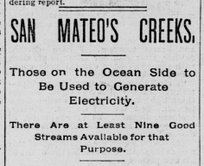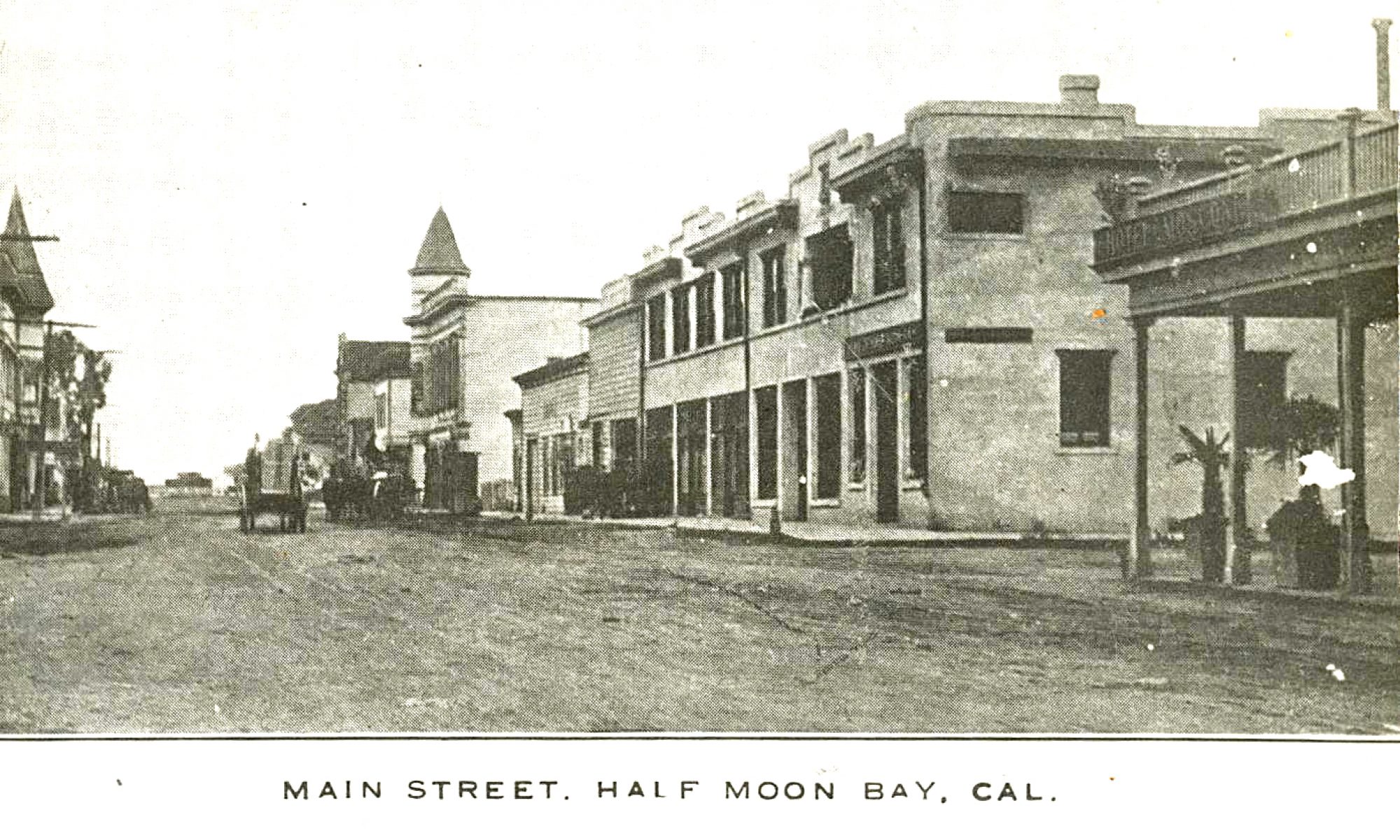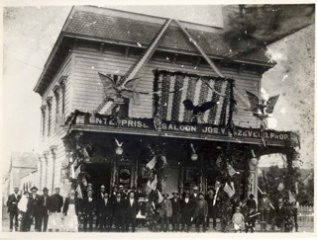
1869: Frederick Marriott & His Flying Machine
A new-old story by June Morrall
[Image below: Frederick Marriott]
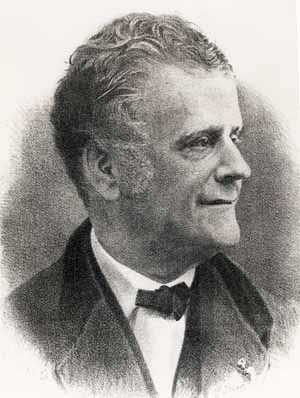
Frederick Marriott & His Flying Machine
[Note: Frederick Marriott came to San Francisco from England propelled by dreams of gold and flying. Failing at the former, he turned to the latter, launching his dreamship, the “Avitor Hermes,” in 1869 in San Mateo County.]
The skies were clear and spirits high 138 years ago when shareholders with Aerial Steam Navigation Company gathered near Shell Mound Park–where Broadway in Burlingame is today–for the test flight of the Avitor Hermes.
In this age of hydrogen-filled balloons the Hermes was a technological leap forward, cigar shaped and equipped with a steam engine.
Invented and built at the San Mateo County Avitor Works, the Hermes was aviation pioneer Frederick Marriott’s entry in the world’s race to tame the skies for fun and profit.
Marriott zealously believed that the future belonged to steam-propelled, lighter-than-air-craft, despite the emphasis in London, Paris and Berlin on designing heavier-than-air flying machines.
So confident was Marriott of his invention, that he had raced its development against completion of the transcontinental railroad, linking the West and East coasts.
Born in 1805 in Enfield, England, Marriott witnessed the Industrial Revolution’s scientific and engineering breakthroughs, revolutionizing everyday life. The Age of Scientific Wonders captivated people, and they embraced the outpouring of inventions, including the amazing steam engine.
In his youth, Marriott traveled from England to India as an employee of the East India Company. Upon returning to his native country, his wealthy wife made it possible for him to invest in various enterprises, most of which failed. Finally he settled on a journalism career, helping launch the “Illustrated London News,” known for its graphics of the latest scientific advances, including mechanical balloon inventions.
By the 1840s Marriott’s vision of flying contraptions had reached the realm of science fiction. Equally imaginative were the names of his fanciful air carriages: “Blazing Comet,” “Lively Sal,” and “High Flyer.”
Almost religious in his fervor to conquer the sky’s highways, he boasted of future aircraft delivering mail and and passengers from San Francisco to New York–and ultimately to all the great cities of the world.
His tenure at the “News” probably put him in contact with two British aeronautical historical figures: civil engineer William Samuel Henson and inventor John Stringfellow. As proprietors of the Aerial Transit Company, they were experimenting with heavier-than-air flying machines. In the capacity of stockholder and publicist, Marriott joined the company,but one year later the two inventors bought him out.
In 1843 Marriott viewed an unofficial exhibition of the Ariel, William Henson’s model steam-driven “aeroplane,” propelled by two six-bladed pusher air screws at London’s Adelaide Gallery, where scientific experiments were conducted. Enveloped by a cloud of steam, the Aerial reportedly stunned observers who watched the flying machine roll along the ground and take off into the air. But experts declared the trial indecisive: problems with the model’s power-weight ratio left anxious sky- watchers to await the next episode in the conquest of the air.
Marriott’s flying machine “mania” was next nourished by an astonishing aviation exploit published by the “New York Sun” in 1844, which announced the balloon, “Victoria,” had crossed the Atlantic Ocean in three days.
Only later was it revealed that the “New York Sun’s” newspaper report was pure fiction, deftly blended with scientific data. The “Balloon Hoax” was the creative work of soon-to-be famous author Edgar Allan Poe.
Though filled with dreams of flying his own machines, Marriott sailed for San Francisco via Cape Horn to dig for gold. Instead, he succeeded as a banker, providing real estate loans out of a tent -office in San Francisco. He used profits to finance the building of his own lighter-than-air steam-powered balloon.
Closing down the banking business, Frederick Marriott fell back on his journalistic talent, founding the quirky “San Francisco News Letter” in 1856. Originally a sheet of blue paper, with news items on one side, the “Letter” had one side blank for pioneer San Franciscans to correspond with their relatives worldwide. The novel ideal brought him immediate success.
In the 186os Marriott’s “News Letter” announced the formation of the Aeronautical Society of Great Britain, an organization welcoming him as a member.
Although the Society favored heavier-than-air flying machines, Marriott kept focussed on developing a gas-filled fantasy air carriage.
Marriott’s longtime love affair with flying machines finally changed from a dreamy vision to an actual model in 1866. In his Avitor Works building near Ansel Easton’s Shell Park Course, the cherubic Marriott proudly inspected the the lighter-than-air machine created by his engineers.
He dubbed the craft the “Avitor Hermes,” probably named for the mythological Greek god of science and patron of science. When perfected, Marriott felt certain the small steam engine would lift the “stately little fellow” 120 feet off the ground, propelling it forward at speeds of 100 miles per hour.
Drawing on his public relations skills, he used the News Letter to publicize his invention. One gimmick was a page devoted to futuristic “Avitor Literature,” Marriott’s version of science fiction. He fantasized air carriages cruising the skies from New York to Hong Kong to Jerusalem and Baghdad, encountering and ducking all kinds of atmospheric dangers.
His “Letter” drummed up support for the Hermes, including that of Belmont banker William Ralston.
Weather and technical problems forced postponement of the gaseous craft for three years, although in 1867–to keep interest alive–Marriott gave a “San Francisco Bulletin” a peek at the Hermes. The reporter described a “hybrid between a fish and short-billed, short-necked, plump bird stretched out in the act of flying. The outlines and general features are as unlike the sketches and caricatures that have been put out as a crab is unlike a quail…”
After the reporter’s visit, the design changed to resemble what many defined as a 37-foot-long cigar shaped balloon, inflated with hydrogen gas. A ribbed propeller, not unlike that of a steamship, pushed the machine ahead while a rudder steered it.
With problems resolved, Marriott set new dates for private and public showings of the patented Hermes, but he was to suffer great disappointment on May 10, 1869, when the Central Pacific and Union Pacific railroads joined rails, snuffing out his dream of upstaging that historic event.
Nonetheless, on July 2, a nearly windless day, Aerial Steam Navigation Company shareholders rode the San Francisco-San Jose Railroad to the Millbrae station in San Mateo County. From there, buggies escorted the men a mile-and-a-half to Shell Mound Park.
At the appointed time, Hermes floated out of the Avitor Works and across Ansel Easton’s Shell Mound Park to the center of the field. The two-bladed propellers powered up and the hydrogen gas lifted the Hermes slowly into the air. Two men, standing fore and aft, held lines fastened to the Hermes–preventing the balloon from floating away–and followed the craft around the track at a dog trot. The performance, said to have covered approximately one mile, at 5 mph was accomplished twice.
Marriott’s “San Francisco News Letter” trumpeted the successful Hermes flight.
Two days later Marriott had to demonstrate the Avitor Hermes could perform again, this time in front of 100 viewers at Shell Mound Park. But stiff breezes deemed an outdoor exhibition impossible, so the craft was brought back inside the Avitor Works where the Hermes was powered up and rose off the ground.
The “New York Times” pointed out that the Hermes had demonstrated its inability to steer into or against the winds. Yet there was “germ of success” since the machine rose in the air and was propelled forward and backward.
The “San Francisco Daily Alta” exuded disillusionment, believing the source of power insufficient and the present affair hopeless.
In late July, the Hermes was exhibited at San Francisco’s Industrial Pavilion where thousands of school children paid ten cents each to view the air carriage rise above the floor.
Then, in a tournament, Marriott changed his mind about the feasibility of steam-powered, lighter-than-air balloon craft. In the 1880s he announced plans to build a 150-foot long, heavier-than-air flying machine called the “Leland Stanford,” and slated a future test flight from Woodward Gardens in San Francisco to Menlo Park. Marriott’s application for the new patent was turned down on scientific grounds.
The Avitor Hermes, built at San Mateo County’s Shell Mound Park, was consumed by a fire in San Francisco, according to extensive archives at the San Mateo County History Museum in Redwood City.
Frederick Marriott died in San Francisco on December 16, 1884, never fully realizing his dreams of conquering the air. Some say Marriott remains an unrecognized aviation pioneer, inventor of a steam-driven aircraft which made successful flights in California 34 years before the Wright Brothers legendary event at Kitty Hawk, North Carolina.
….more coming….
1890s: Will Spanishtown Go for McKinley?
From San Mateo Times & Gazette, 1890s
Enthusiastic Silver Advocates at Half Moon Bay
Words of Commendation for Supervisor McAvoy from a Prominent and Substantial Source
Half Moon Bay
Is [Presidential candidate William] McKinley going to carry Spanishtown? Well I guess not judging by the Democratic enthusiasm last Saturday night at the organization of the silver club. With only a few hours notice, thirty citizens were gathered in Pacific Hall. W.J. Savage called the meeting to order. Mr. Keeling was elected temporary chairman. In a few minutes he explained the objects of the meeting. Then the rolls were offered for signatures and all present signed and one was a convert from the McKinley Club.
Armand Levy was elected permanent chairman; Joseph McCarthy, secretary, Ed Campbell, F.B. Mosely, J.P. Quinlan, vice presidents, Joseph Debenedetti, treasurer, George Keeling, Alvin Hatch, Sidney Smith, F.B. Mosely and W.J. Savage managing committee. As each officer was elected he was called upon for a speech. To show the confidence of the members in their cause, the secretary was instructed to debate the issue of the campaign at any time or place agreeable to the gold men, the debate meeting to be open to the public, outside talent barred.
The McKinley club had been in existence a fortnight but that of free silver on the night of its organization almost doubled it in membership, and yet they dare say this town is for gold. The club meets again next Saturday night. Several good speakers will be on hand to speak upon the issues of the day. The public is invited to attend. Anyone who wishes to join the cause of the people against Hanna and the rest of the monopolists will find the roll at Levy Bros. store. Sign it and work for prosperity.
1890s: July 4th in Half Moon Bay
[Image below: A small march down Main Street when “Red’s” stood across the way from Isadore’s Garage, all long gone. I will add pix of much older 4th of July photos for your enjoyment.]
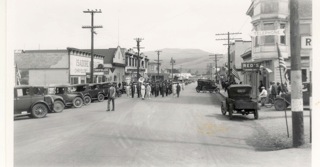
An old-new story by June Morrall (I wrote this in the 1970s)
July 4th Celebrations at Half Moon Bay in the 1890s: A Portrait of One Day
All day long a steady stream of visitors poured into Half Moon Bay, many of them from as far away as San Francisco. By noon, the line of horse and buggies parked along Main Street resembled a crowded city scene.
A local newspaper estimated that at least 300 “strangers,” showed up, adding up to one of the largest gatherings ever seen in the 1890s to celebrate the Fourth of July.
The townspeople were prepared. As early as the day before, they were busy getting ready for the 114th anniversary of American independence. Everyone pitched in to decorate, draping bunting and streamers over business establishments and private homes.
Not only the American flag, but a display of banners from all over the world produced an instant flash of color. It was a warm, lightly breezy day and the flags lazily floated out of all but a few homes in the entire “valley.”
Overnight the old Coastside town achieved a patriotic look.
Promptly, at sunrise, early pioneer W.A. Simmons fired the town’s five pound cannon and led the national salute. Soon afterward, droves of folks arrived from the country in a holiday mood. Young and old dressed for the special occasion, filling Main Street, a dirt road then, as the popping sound of small firecrackers filled the air.
It seems that whenever a committee is responsible for a big event, like this Fourth of July in the 1890s, there were differences between the members that had to be worked out–and they were, according to some amicably solved.
Others said the plans almost backfired.
But on the day of the event you wouldn’t know there had been any troubles, and the rolling vehicles, prancing horses and excited children pointed to a successful, lively atmosphere.
[Image below: A Half Moon Bay float….]

The crowd’s noise was muffled when the ceremonial unfurling of the flags began in unison from the roofs of the businesses on and around Main Street including Levy Brothers, R.I. Knapp’s Plow Factory, William Pringle’s Harness Shop, Boitano Brothers and Debenedetti’s.
But the sound of loud firecrackers soon broke the solemnity of the moment as clusters of visitors started talking above the noise, looking forward to the next event: the parade.
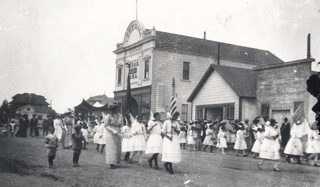
It was early in the morning, and at 10 a.m. sharp, the honorary “president of the day” headed for Schuyler’s Hotel to take his place at the head of the procession. All the movers and shakers took their place as they marched down Kelly Street, preceded by the Half Moon Bay Cornet Band , in their third public appearance, opening up with a rousing rendition of the “Star Spangled Banner.” Behind the band was the eye-catching Fourth of July float, dressed up with pretty local girls, carefully decorated and drawn by an impressive team of horses moving at a fast pace.
Once on Main Street, the parade turned south toward Miramontes Street; the procession stopped outside the school located nearby. (Meanwhile children scrambled to catch-up, as the older folk strolled alone or rode along slowly in their carriages. Yes, it was a Norman Rockwell scene.)
Near the school, and in the shade of a grove of big old Cedar trees, stood a recently constructed stage, also decorated with heavy bunting and flags. At the time, what was called a tableaux,” where “actors and actresses” created a live picture, a symbolic statement, was anxiously awaited. This day’s tableaux was called “Colonial Times,” and it was obvious as the nervous actors, 13 identically attired girls in all-white, assembled on the stage. Each girl bore a sash with a name of the original 13 colonies.
But more actors joined the group representing “Liberty,” “Army,” “Navy,” “George and Lady Washington,” all frozen in a symbolic silence.
The event’s “presidents” role was to introduce the participants as well as the children and adults who read poetry or sang, for that was the popular entertainment of the 1890s. [In fact, when the eccentric Tunitas Creek sculptress Sybil Easterday was a child, she acquired fame for her cuteness as well as her elocution skills.]
There were a series of recitations, names of which we are unfamiliar with today: “Independence Day,” “E Pluribus Unum, and halfway through the program Rev. B.F. Taylor delivered an uplifting address. The program ended with the audience singing “America,” as the curtain dropped on the frozen tableaux.
The Half Moon Bay Cornet Band struck up a tune called “Our Flag is There,” and the inexperienced school kids did their best singing in tune the exciting number known as “Red, White and Blue.”
All this made for great fun, and at the right moment, a new flag was raised by school officials. It was a perfect day. The flag fluttered in the light breeze followed by a growing ripple of applause from the crowd.
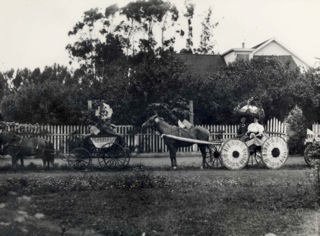
More festivities followed with a grand party at the “Pacific Hall,” with music provided by the Melville Brothers, a popular contemporary band. At midnight the the ladies committee served a hot meal at the Ocean Shore Hotel (the location of which I do not know as I do not know where the “Pacific Hall” stood, either.) This Fourth of July was so much fun for everyone that no one wanted to leave until dawn approached.
————-
But the following year, when the Fourth of July rolled around, the event was disorganized, without focus and direction. It was the sudden death of an important citizen, and the subsequent funeral, that threw all the plans for the celebration off schedule.
The committee was frazzled without their leader, so recently buried. [No I do not know who he or she was.] The festivities did not begin at 10 a.m. but four hours later; the band did not play on time. Songs were canceled, and so were the literary recitations.
Things got so bad that the committee just wanted the event to be over. They didn’t even want it to happen, but there were those expectations. The schoolchildren were encouraged to rush through their carefully prepared performance; the Declaration of Independence was hastily read, the words mumbled. Usually a highlight, hardly anyone showed up for the afternoon barbecue. The entire day was an embarrassment.
The dark clouds of a ruined event just wouldn’t let the sunshine in. The day included a baseball game between the Monitors and the Scrubs and the usually avid fans could muster any enthusiasm when, after three quick innings, the Monitors clinched the title.
The only redeeming feature were the famous horse races held on Main Street (trotting, buggy and half-mile races) The rural farming community had a deep respect for fine Coastside horses, and that excitement drew the crowds. [You might notice a few balconies that still exist above businesses on Main Street from which families watched the races and parades.]
This Fourth of July that began in a shaky state got better when locals competed in foot races to demonstrate their physical agility. In the 100 yard sprint, Joe Quinlan, came in first and won a silk shirt. There were races for married men and an unscheduled race between two mules.
In the end, although this Fourth of July could have been a total disaster, a couple of hundred guests showed up at the Pacific Hall for supper, and the Fourth of July committee, although thrown off without their capable leader, declared the day a partial success.
more to come….
Peter Adams’ BIG Adventure
Story by Peter Adams
Email Peter ([email protected])
Have attached some photos for a light note. these are of my taking out noah, who is ‘gibby’ from the popular kid tv show icarly, for his first ocean kayak adventure. …beautiful day!
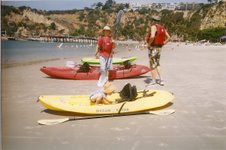
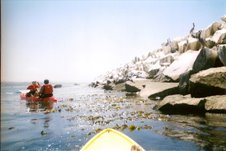
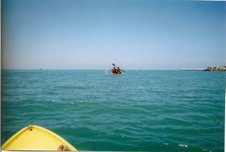
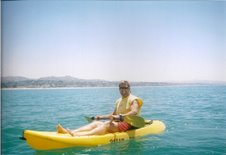
Teacher/Editor Walter Ruhlman: Passions
Story from Walter Ruhlman
Hello dear ones
A new publication by mgversion2>publishing is online.
A monodrama by French poet, novellist and playwright Denis Emorine, translated into English by Brian Cole and illustrated by Norman J. Olson.
Find out more about it here http://mgversion2.free.fr/publishing/publicata.html
Walter Ruhlmann
http://mgversion2.free.fr
[email protected]
Ladies enjoying the Coastside
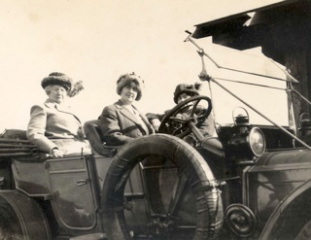
John Vonderlin: Where did Devil’s Slide get its Name?
Story by John Vonderlin
Email John ([email protected])
Did the United States Geological Survey Name Devil’s Slide in 1896?
Hi June,
No luck in finding origin of Devil’s Slide’s name, but I’ve attached a USGS map from 1896 with it named. Enjoy. John
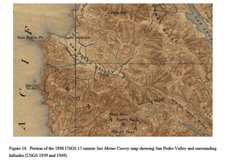
Montara: What’s Was Up in Nov. 1919
From the “Coastside Comet”
At Montara
Las Cabritas Ranch will exhibit twenty-seven goats in the Pure Bred Live Stock show in San Francisco from Nov. 1 – 8. We expect to see them return with a lot of prizes.
[Image below: The Montara Goats Las Cabritas Ranch.]
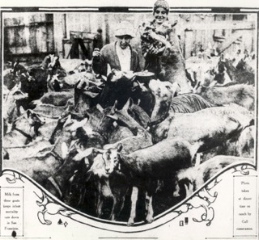
The Wilson cottage, the Amos cottage, the Dr. Thomas cottage, the Wheeler house (image below)
 the Maier mansion, the Weyl cottage have all been rented recently for the Winter months, which shows that the people are beginning to appreciate our fine Winter climate.
the Maier mansion, the Weyl cottage have all been rented recently for the Winter months, which shows that the people are beginning to appreciate our fine Winter climate.
[Image below: Houses in early Montara. I haven’t found the Wheeler pix yet but it may be in this shot anyway. I will post it when I locate it.
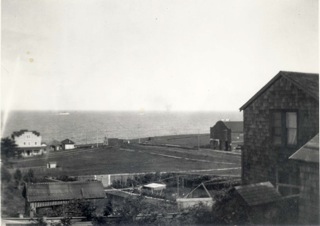
Arthur Wagner, wife, daughter, Dorothy and Jean Ross of Salada Beach are touring in the mountains above Placerville for a few days.
Geo. M. Havice and wife of Montrose, Colorado, formerly of Montara and Mexico have located for the winter in the Wheeler House.They have many friends here who will welcome them back. Mr. and Mrs. Havice own considerable property here and also in the Montara Realty Development Company.
Mr. Wilcox has three of the largest potatoes of the season on exhibit at the post office; one of them weighs two and a half pounds.Who can beat it?
The United States Government is at the present time installing a powerful wireless station at Point Montara Lighthouse Station.
[Image below: The Montara Lighthouse and Diaphone Signal Station.]
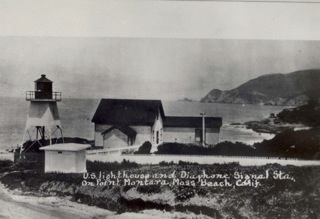
Mr. and Mrs. Drew of New York [ed. I actually met one of the Drews, Gretchen Drew in San Francisco in the 1970s; she was a friend of Peter B. Kyne, the writer and gave me an autographed photo which is now in the archives of the San Mateo County History Museum]. has leased the house recently occupied by Rev. Osborn and will remain here permanently.
There is so much property around Montara that is improved that can be bought at such bargains that it will only be a short time until there is a more stable real estate market and the bargains snapped up.
It is to be hoped that the people will remember that there are services at the church every Sunday morning at 11 a.m. Rev. Mr. Osborne, pastor.
Miss Bessie Chase, who is spending a vacation at home has been busy decorating the interior of their beautiful home. She is quite an artist with the paint brushes.
Miss Irma Hazard, the Montara school teacher was appointed by Senator M. B. Johnson on the Roosevelt Committee to take part ….(words missing…)
Mrs. Will John Wagner , who has been visiting relatives in Los Angeles, will return to her home in Montara soon.
The county board of supervisors are to construct a reinforced concrete retaining wall on the San Gregorio Road.
The young man who learns to depend first upon himself will seldom have to appeal to others.
Andrew Stirling and Frank Zug, Coastside men, charged with an assault upon Frank Goularte of Pescadero on the night of September 27th at San Gregorio, were arraigned in Justice of the Peace Ray Griffin’s court in Redwood Saturday morning. Both men pleaded not guilty to the charge and the preliminary trial of Zug was set for November 11. The time of the trial for Stirling will be set on that date. The alleged attack on Goularte was the outcome of a quarrel over the recent Sarah Satira Coburn murder investigation.
J. Emmett Fitzgerald is the new owner of Lot 45, block 24, Montara.
Officials of the Toyo Kisen Kaisha are waiting permission from the Navy Department to place the Nippon Maru, recently ashore at Princeton, in drydock at Mare Island for examination before her next departure for the Orient.
==============
Congressman Hugh S. Hersman has been advised by the War Department that every enlisted man in the American Army was entitled to permanently retain, upon discharge, the following property:
1 overseas cap (for all men who have had service overseas) or 1 hat and 1 hat cord for all other enlisted men.
1 olive drab shirt
1 service coat and ornaments
1 pair breeches
1 pair shoes
1 pair leggings
1 barrack bag
1 waist belt
1 set toilet articles if in possession when discharged
1 slicker
1 overcoat
2 suits underwear
4 pairs stockings
1 pair stockings
3 scarlet chevrons
1 gas mask and helmet. (if issued overseas.)
=========================================================
John Vonderlin: 1895/ Plans to Harness Coastside Creeks for Electricity
Story from John Vonderlin
Email John ([email protected])
Hi June,
This September 9th, 1895, article from the “Call,” lays
out the theoretical plans of that time, to harvest the hydro-
power potential of the Coastside. The mentioning of how
the water of the streams is “running to waste” by going
into the ocean, tells a lot about policymakers’ attitudes
of that era.
Enjoy. John
SAN MATEO’S CREEKS
Those on the Ocean Side to
Be Used to Generate
Electricity.
There Are at Least Nine Good
Streams Available for that
Purpose.
REDWOOD CITY, Cal., Sept. 8.— The
question of a water supply sufficient to
generate electric power is being considered
by practical men who have recently visited
the coast side of San Mateo County. The
possibilities of the Pillarcitos, Purissimo,(sic)
Lobitas, Tunitas, San Gregorio, Pomponia,
(sic) Pescadero, Britano (sic) and Gazas (sic)
creeks have been under consideration with a
view of putting in dams and dynamos to gen-
erate power for an electric railroad to connect
the coastside towns with San Francisco;
also with reference to the transmission of
electric power to San Francisco for general
uses.
These streams of water rise among the
mountains at intervals of every few miles
and run to and empty into the ocean.
With the exception of the San Francis-
quito and San Mateo creeks, they find no
counterpart on the bay side of the county.
Heretofore these waters on the ocean
side have been considered most valuable
as being part of the available supply for
the domestic uses of San Francisco. The
Spring Valley Water Works is a large
owner of lands and water rights on several
of these steams, although all the great
lakes of the Spring Valley storage system
lie on the easterly or bay side of the
county.
The people of the coast side have waited
many years to learn if additional uses
might not develop, so that the immense
water supply running to waste in the
ocean could be brought under control and
made to produce revenue. The creation
and transmission of electic power may
bring about this result, and also develop
an electric railway system that will place
one of the most charming sections of the
coast within less than an hour’s ride of
San Francisco.
